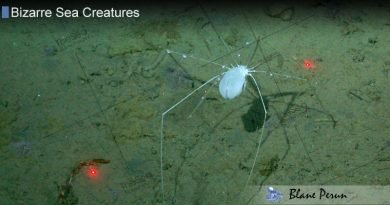Red Handfish
The red handfish (Thymichthys politus) is a small, strange, angry-looking benthic creature that lives in the waters that surround Australia, more exactly Tasmania. Their preferred places are rocky areas, where they can spend time on top of the rocks as well as between the rocks and in the sandy areas at the edge of the reefs.
The name is a revealing one: the animal’s body is either embellished with bright red lines or is completely red and it often uses its hand-like appendages to move around on the sea floor, producing motion that is very similar to walking. It is a small creature, growing to only about 13 cm in length.
The red handfish proliferates through spawning, but it has a very low success rate and even that low rate depends on the availability of green algae that seems to be indispensable for the spawning process to take place at all. Scientists believe that the animal feeds on very little, almost invisible worms and tiny crustaceans.
The species had been discovered in the 19th century, near Port Arthur, but no individuals were encountered for a long time, until the 1980s, when a small population was discovered. In the 1990s, another group of ten specimens was encountered around the reefs off Primrose Sands, but the scientists who returned to the area in 2005 found no red handfish there. According to the estimations, however, there might still be around 1,000 individuals out there, walking the seabed.
Discovering the Rare Gem of the Sea: The Red Handfish
The Red Handfish (Thymichthys politus) is an extraordinary creature that paints a vivid tableau of nature’s boundless creativity. Dwelling in the coastal waters of Tasmania, this remarkable fish has captivated the hearts of marine biologists and conservationists worldwide. It’s not just its rarity or its peculiar mode of locomotion that fascinates observers but also its critical status that demands urgent attention and action.
Unveiling the Mystery: What is a Red Handfish?
The Red Handfish is a benthic species, meaning it resides near the sea floor. Unlike many other fish that swim with the use of their tails, the Red Handfish ‘walks’ using its pectoral fins that resemble hands—hence the name. This species is distinguished by its striking red coloration, intricate fin patterns, and a demeanor that reflects a bygone era when the oceans were less explored.
A Deep Dive into the Red Handfish Habitat
Native to the temperate waters off the coast of Southeast Tasmania, the Red Handfish prefers habitats that are replete with spongy corals and seaweed, providing both camouflage and a breeding ground. Unfortunately, their specialized habitat requirements make them vulnerable to environmental changes, including pollution and climate change.
Understanding the Red Handfish Population
The population of Red Handfish is alarmingly small, with estimates suggesting fewer than 100 individuals remaining in the wild. This critically low number places the species on the brink of extinction and highlights the need for immediate conservation efforts.
The Biology and Behavior of the Red Handfish
Astonishingly, the Red Handfish leads a sedentary lifestyle, moving infrequently which contributes to its limited dispersal and colonization. They are known to lay eggs on the stalks of seaweed, and the juveniles are miniature replicas of the adults, fully equipped to ‘walk’ along the ocean floor from the moment they hatch.
Conservation Measures: Protecting the Red Handfish
Conservation efforts for the Red Handfish are multifaceted, involving habitat protection, pollution control, and raising public awareness. Scientific communities are working tirelessly to monitor populations and potentially develop breeding programs to avert the risk of extinction.
Interactions with Humans and the Red Handfish
Human activities have significantly impacted the Red Handfish, particularly through habitat degradation. Ensuring the survival of this species requires a concerted effort to minimize our footprint on their ecosystems.
FAQs About the Red Handfish
- How does the Red Handfish move? The Red Handfish uses its pectoral fins, which resemble hands, to ‘walk’ along the sea floor rather than swimming.
- Why is the Red Handfish endangered? The Red Handfish is endangered due to its extremely limited distribution, specialized habitat requirements, and threats from human-induced environmental changes.
- What is being done to save the Red Handfish? Conservation strategies include habitat preservation, research on population dynamics, and public education to foster conservation efforts.
- Can the Red Handfish be found in aquariums? Due to their critical status, Red Handfish are not typically found in aquariums, and efforts are focused on their conservation in the wild.
- What can individuals do to help the Red Handfish? Individuals can support conservation organizations, reduce pollution, and advocate for marine protected areas to help conserve the Red Handfish’s habitat.
Conclusion
The Red Handfish is a testament to the diverse and intricate tapestry of life beneath the waves. As stewards of the Earth, it is our responsibility to ensure that future generations may continue to marvel at this species.




